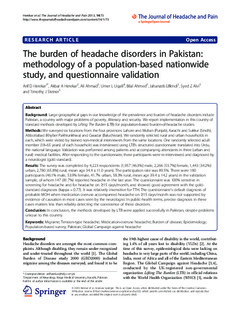| dc.description.abstract | Background
Large geographical gaps in our knowledge of the prevalence and burden of headache disorders include Pakistan, a country with major problems of poverty, illiteracy and security. We report implementation in this country of standard methods developed by Lifting The Burden (LTB) for population-based burden-of-headache studies.
Methods
We surveyed six locations from the four provinces: Lahore and Multan (Punjab), Karachi and Sukkur (Sindh), Abbottabad (Khyber Pakhtunkhwa) and Gwadar (Baluchistan). We randomly selected rural and urban households in each, which were visited by trained non-medical interviewers from the same locations. One randomly selected adult member (18–65 years) of each household was interviewed using LTB’s structured questionnaire translated into Urdu, the national language. Validation was performed among patients and accompanying attendants in three (urban and rural) medical facilities. After responding to the questionnaire, these participants were re-interviewed and diagnosed by a neurologist (gold standard).
Results
The survey was completed by 4,223 respondents (1,957 [46.3%] male, 2,266 [53.7%] female, 1,443 [34.2%] urban, 2,780 [65.8%] rural, mean age 34.4 ± 11.0 years). The participation rate was 89.5%. There were 180 participants (46.1% male, 53.9% female, 41.7% urban, 58.3% rural, mean age 39.4 ± 14.2 years) in the validation sample, of whom 147 (81.7%) reported headache in the last year. The questionnaire was 100% sensitive in screening for headache and for headache on ≥15 days/month, and showed good agreement with the gold-standard diagnoses (kappa = 0.77). It was relatively insensitive for TTH. The questionnaire’s default diagnosis of probable MOH when medication overuse accompanied headache on ≥15 days/month was not supported by evidence of causation in most cases seen by the neurologist. In public-health terms, precise diagnosis in these cases matters less than reliably detecting the coexistence of these disorders.
Conclusion
In conclusion, the methods developed by LTB were applied successfully in Pakistan, despite problems unique to this country. | nb_NO |

